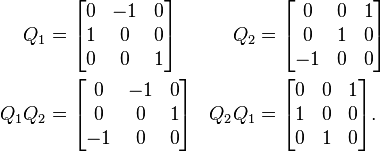Multiplication
The inverse of a rotation matrix is its transpose, which is also a rotation matrix:
The product of two rotation matrices is a rotation matrix:
For n greater than 2, multiplication of n×n rotation matrices is not commutative.
Noting that any identity matrix is a rotation matrix, and that matrix multiplication is associative, we may summarize all these properties by saying that the n×n rotation matrices form a group, which for n > 2 is non-abelian. Called a special orthogonal group, and denoted by SO(n), SO(n,R), SOn, or SOn(R), the group of n×n rotation matrices is isomorphic to the group of rotations in an n-dimensional space. This means that multiplication of rotation matrices corresponds to composition of rotations, applied in left-to-right order of their corresponding matrices.
Read more about this topic: Rotation Matrix

